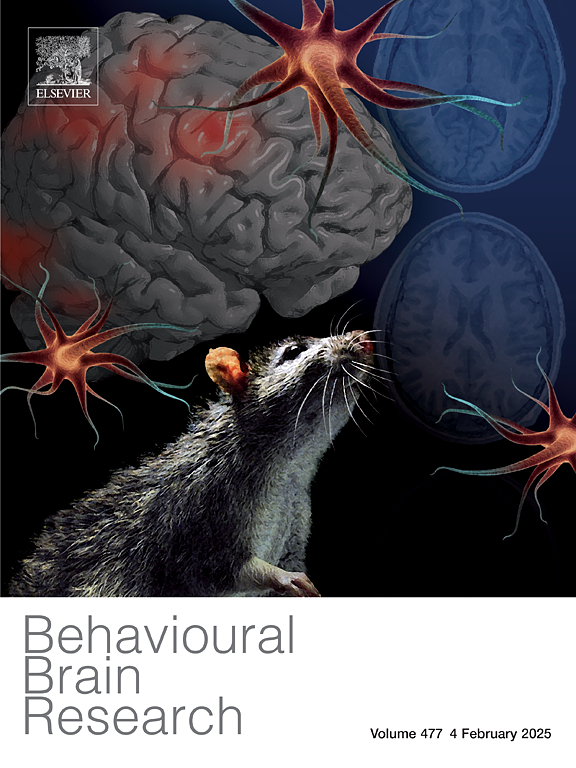Metabolic clues to memory loss: High-fat diets and brain-adipose crosstalk in zebrafish
IF 2.6
3区 心理学
Q2 BEHAVIORAL SCIENCES
引用次数: 0
Abstract
Obesity is a growing public health concern that significantly impacts cognitive functions, including memory. This research explores how a high-fat diet affects short-term memory, employing the novel object recognition (NOR) test and NMR-based metabolomics to elucidate metabolic alterations in the brain and adipose tissue. The zebrafish were divided into two groups: one receiving a standard diet (SD) and the other a high-fat diet (HFD). Body mass index (BMI) was assessed every two weeks for a period of eight weeks. The NOR test was used to determine the discrimination index (DI) for evaluating the short-term memory of the SD and HFD groups. NMR spectroscopy was employed to investigate the metabolites in brain and adipose tissues, and multivariate data analysis was conducted to discover significant metabolic alterations. The high-fat diet (HFD) resulted in a significant increase in body mass index (BMI) (p < 0.0001) compared to the standard diet (SD) group from week 4 to week 8. A significant reduction in the discrimination index (24.95 %) in the HFD group against the SD group suggests a decline in memory performance among HFD subjects. NMR-based metabolomics of adipose tissue revealed that linoleic acid and caprylic acid were consistently found to exhibit increased levels in the HFD group across all assessments, whereas lauric acid, ALA, EPA, and DHA were consistently present at elevated levels in the adipose tissue of the SD group. NMR-based metabolomics of the brain identified GABA, taurine, and histamine as the key metabolites distinguishing the HFD from the SD group in female zebrafish. For male zebrafish brains, taurine, phenylalanine, and tryptophan were identified as the most significant metabolites for differentiating between HFD and SD. These metabolites demonstrated a notable decrease in the HFD group relative to the SD group. The results of this study align with those of previously reported studies in rodents and humans, indicating that memory impairment associated with obesity may stem from neuroinflammation and changes in synaptic plasticity. This research provides insights into the molecular changes in adipose tissue and the brain that occur when individuals receive a high-fat diet (HFD), which may enhance our understanding of the link between obesity and memory impairment, ultimately leading to a better comprehension of the disease.
肥胖是一个日益令人担忧的公共健康问题,严重影响包括记忆在内的认知功能。本研究采用新型物体识别(NOR)测试和基于核磁共振的代谢组学来阐明大脑和脂肪组织的代谢变化,从而探索高脂饮食如何影响短期记忆。斑马鱼被分为两组:一组接受标准饮食(SD),另一组接受高脂肪饮食(HFD)。在为期八周的时间里,每两周对体重指数(BMI)进行一次评估。采用 NOR 测试确定辨别指数 (DI),以评估 SD 组和 HFD 组的短期记忆力。采用核磁共振波谱研究大脑和脂肪组织中的代谢物,并进行多元数据分析以发现显著的代谢改变。从第 4 周到第 8 周,与标准饮食组相比,高脂饮食组的体重指数(BMI)显著增加(p < 0.0001)。与标准饮食组相比,高脂饮食组的辨别指数明显下降(24.95%),这表明高脂饮食组受试者的记忆能力有所下降。基于核磁共振技术的脂肪组织代谢组学研究显示,在所有评估中,高脂饮食组的亚油酸和辛酸水平持续升高,而低脂饮食组的月桂酸、ALA、EPA 和 DHA 水平持续升高。基于核磁共振的脑代谢组学发现,GABA、牛磺酸和组胺是区分雌性斑马鱼高脂饮食组与标清组的关键代谢物。在雄性斑马鱼大脑中,牛磺酸、苯丙氨酸和色氨酸被确定为区分高频分解与低频分解的最重要代谢物。与标清组相比,HFD 组的这些代谢物明显减少。这项研究的结果与之前报道的啮齿类动物和人类研究结果一致,表明与肥胖相关的记忆损伤可能源于神经炎症和突触可塑性的变化。这项研究深入揭示了人在接受高脂饮食(HFD)时脂肪组织和大脑中发生的分子变化,这可能会加深我们对肥胖与记忆损伤之间联系的理解,最终导致更好地理解这种疾病。
本文章由计算机程序翻译,如有差异,请以英文原文为准。
求助全文
约1分钟内获得全文
求助全文
来源期刊

Behavioural Brain Research
医学-行为科学
CiteScore
5.60
自引率
0.00%
发文量
383
审稿时长
61 days
期刊介绍:
Behavioural Brain Research is an international, interdisciplinary journal dedicated to the publication of articles in the field of behavioural neuroscience, broadly defined. Contributions from the entire range of disciplines that comprise the neurosciences, behavioural sciences or cognitive sciences are appropriate, as long as the goal is to delineate the neural mechanisms underlying behaviour. Thus, studies may range from neurophysiological, neuroanatomical, neurochemical or neuropharmacological analysis of brain-behaviour relations, including the use of molecular genetic or behavioural genetic approaches, to studies that involve the use of brain imaging techniques, to neuroethological studies. Reports of original research, of major methodological advances, or of novel conceptual approaches are all encouraged. The journal will also consider critical reviews on selected topics.
 求助内容:
求助内容: 应助结果提醒方式:
应助结果提醒方式:


